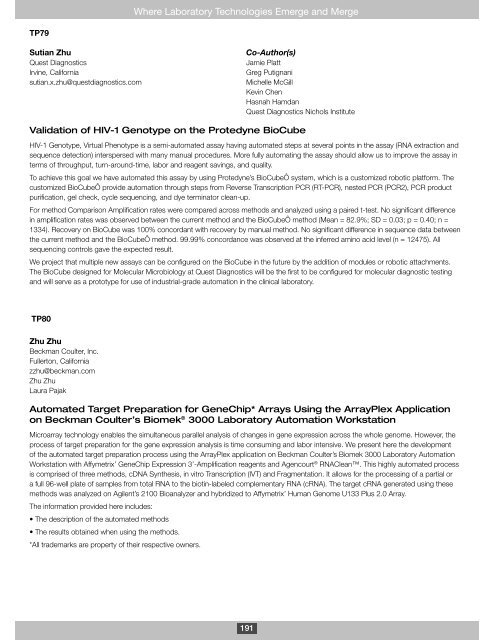LabAutomation 2006 - SLAS
LabAutomation 2006 - SLAS
LabAutomation 2006 - SLAS
Create successful ePaper yourself
Turn your PDF publications into a flip-book with our unique Google optimized e-Paper software.
TP79<br />
Sutian Zhu<br />
Quest Diagnostics<br />
Irvine, California<br />
sutian.x.zhu@questdiagnostics.com<br />
Where Laboratory Technologies Emerge and Merge<br />
Co-Author(s)<br />
Jamie Platt<br />
Greg Putignani<br />
Michelle McGill<br />
Kevin Chen<br />
Hasnah Hamdan<br />
Quest Diagnostics Nichols Institute<br />
Validation of HIV-1 Genotype on the Protedyne BioCube<br />
HIV-1 Genotype, Virtual Phenotype is a semi-automated assay having automated steps at several points in the assay (RNA extraction and<br />
sequence detection) interspersed with many manual procedures. More fully automating the assay should allow us to improve the assay in<br />
terms of throughput, turn-around-time, labor and reagent savings, and quality.<br />
To achieve this goal we have automated this assay by using Protedyne’s BioCubeÔ system, which is a customized robotic platform. The<br />
customized BioCubeÔ provide automation through steps from Reverse Transcription PCR (RT-PCR), nested PCR (PCR2), PCR product<br />
purification, gel check, cycle sequencing, and dye terminator clean-up.<br />
For method Comparison Amplification rates were compared across methods and analyzed using a paired t-test. No significant difference<br />
in amplification rates was observed between the current method and the BioCubeÔ method (Mean = 82.9%; SD = 0.03; p = 0.40; n =<br />
1334). Recovery on BioCube was 100% concordant with recovery by manual method. No significant difference in sequence data between<br />
the current method and the BioCubeÔ method. 99.99% concordance was observed at the inferred amino acid level (n = 12475). All<br />
sequencing controls gave the expected result.<br />
We project that multiple new assays can be configured on the BioCube in the future by the addition of modules or robotic attachments.<br />
The BioCube designed for Molecular Microbiology at Quest Diagnostics will be the first to be configured for molecular diagnostic testing<br />
and will serve as a prototype for use of industrial-grade automation in the clinical laboratory.<br />
TP80<br />
Zhu Zhu<br />
Beckman Coulter, Inc.<br />
Fullerton, California<br />
zzhu@beckman.com<br />
Zhu Zhu<br />
Laura Pajak<br />
Automated Target Preparation for GeneChip* Arrays Using the ArrayPlex Application<br />
on Beckman Coulter’s Biomek ® 3000 Laboratory Automation Workstation<br />
Microarray technology enables the simultaneous parallel analysis of changes in gene expression across the whole genome. However, the<br />
process of target preparation for the gene expression analysis is time consuming and labor intensive. We present here the development<br />
of the automated target preparation process using the ArrayPlex application on Beckman Coulter’s Biomek 3000 Laboratory Automation<br />
Workstation with Affymetrix’ GeneChip Expression 3’-Amplification reagents and Agencourt ® RNAClean. This highly automated process<br />
is comprised of three methods, cDNA Synthesis, in vitro Transcription (IVT) and Fragmentation. It allows for the processing of a partial or<br />
a full 96-well plate of samples from total RNA to the biotin-labeled complementary RNA (cRNA). The target cRNA generated using these<br />
methods was analyzed on Agilent’s 2100 Bioanalyzer and hybridized to Affymetrix’ Human Genome U133 Plus 2.0 Array.<br />
The information provided here includes:<br />
• The description of the automated methods<br />
• The results obtained when using the methods.<br />
*All trademarks are property of their respective owners.<br />
191
















